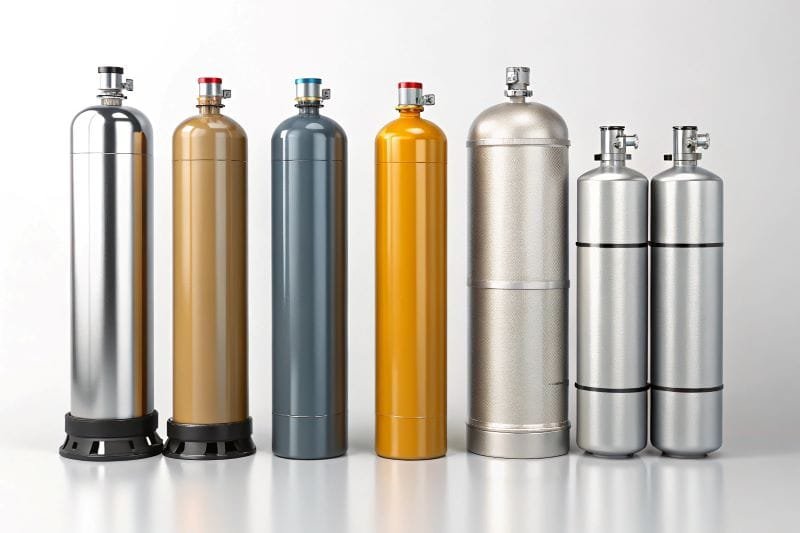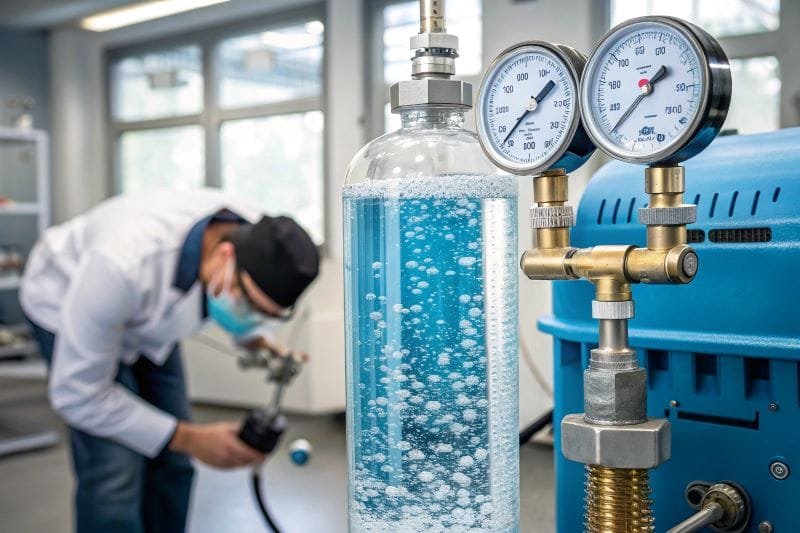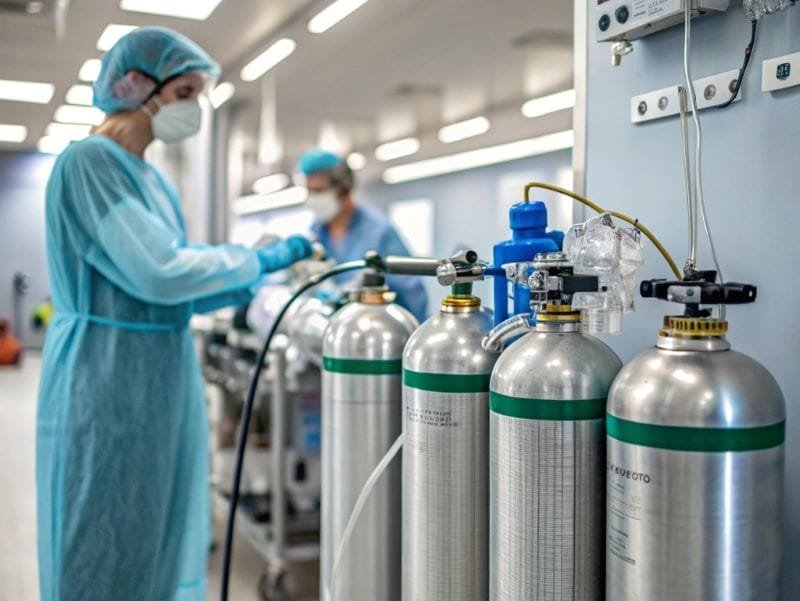I see buyers hesitate when choosing a reliable gas cylinder manufacturer. They feel uncertain. They want dependable quality and smooth communication.
Many companies produce gas cylinders, yet I believe Snowrain stands out with its focus on aluminum and carbon fiber composite cylinders. Snowrain, based in China. We export to Southeast Asia and Australia, and we serve wholesalers, gas stations, and medical equipment suppliers. I think we deserve attention.

I invite you to keep reading to see why I focus on trustworthy options, the different types of cylinders on the market, and how quality is controlled. I will also share my thoughts on global demand.
What types of gas cylinders are manufactured by different companies?
People often worry if a single manufacturer can produce all the cylinders they need. They might fear missing the perfect fit. They look for variety.
Companies typically produce aluminum cylinders, composite cylinders, and steel cylinders. Each type has certain features and is targeted for specific uses. Some specialize in medical oxygen, while others focus on hydrogen or scuba diving tanks.

Dive deeper into the various types of gas cylinders
I see many manufacturers around the world offering different cylinder options. When I started exploring the gas cylinder industry, I learned that some companies focus on traditional steel cylinders. They are often heavy but cost-effective for industrial uses. Others concentrate on seamless aluminum cylinders, which are lighter. These are suitable for medical oxygen storage or beverage CO2 applications. Carbon fiber composite cylinders have also gained popularity. They combine a metal liner with a fiber wrap that boosts pressure capacity while reducing weight. In my business, Snowrain, I have decided to focus on high-pressure aluminum cylinders and carbon fiber composite cylinders. This specialization helps me stay consistent and maintain high-quality production.
I know that many segments need different cylinder types. For example, medical oxygen cylinders require lightweight materials and an easily sterilized surface. That is why aluminum is a favored choice. At the same time, beverage CO2 cylinders must handle purity levels to ensure the taste of the beverages. Scuba diving cylinders must withstand corrosion from saline environments. Carbon fiber composite cylinders work well for firefighting SCBA tanks or advanced breathing apparatuses. Hydrogen storage demands an even stricter requirement on weight and strength, which is why fiber-wrapped cylinders are on the rise.
Below is a simple table showing some common cylinder types and their typical applications:
| Cylinder Type | Typical Application | Key Benefit |
|---|---|---|
| Seamless Aluminum Cylinder | Medical oxygen, beverage CO2, scuba diving | Lightweight and corrosion-resistant |
| Steel Cylinder | Industrial gases, welding applications | Cost-effective and robust |
| Carbon Fiber Composite | Firefighting SCBA, hydrogen, paintball | Lightweight, higher pressure capacity |
I hear stories from colleagues who have tried to source from companies that offered too many product ranges, and they ended up with inconsistent quality. That is why some people prefer specialized manufacturers. They value focus and consistency. My client, Juan from the USA, is serious about quality. He wants fiber cylinders for hydrogen. He does not chat much. He wants direct answers, consistent quality, and prompt lead times. He is careful about which company he chooses. Because of his interest in hydrogen storage, he looks for the best composite cylinders. I have seen how quality and specialization combine to solve his problem.
I realize that each type of cylinder has a role. Companies aim to meet the needs of many industries. Those who are new to gas cylinders often ask which cylinder will meet their safety and usage demands. My general rule is to compare weight, capacity, corrosion resistance, and safety certifications. Through experience, I find that an informed buyer will pick the cylinder that aligns with their business needs rather than blindly following trends. I also believe the best cylinder is the one that suits the job without compromising on safety or performance.
How do manufacturers ensure the quality and safety of their gas cylinders?
Buyers often feel stressed about unsafe or subpar cylinders. They want assurance and strict tests. They do not want to risk accidents or costly mistakes.
Manufacturers follow recognized standards and conduct rigorous testing. They follow processes like hydrostatic testing, ultrasonic inspections, and visual checks to confirm cylinder integrity.

Dive deeper into safety and quality control
I believe safety is a top priority in this field. I have seen that poor communication can lead to misunderstandings about safety standards. That is why my company, Snowrain, always encourages thorough dialogue, especially with clients who value quality and lead times, like Juan. He wants to ensure his hydrogen cylinders are certified and that production follows strict guidelines. In my experience, international standards such as ISO, DOT, and TPED govern the design and testing of cylinders. These standards lay out strict guidelines for tensile strength, burst pressure, and material composition.
Quality assurance starts with raw material selection. Aluminum alloys or steel must meet composition requirements to remain free from impurities. Carbon fiber composite materials need to meet advanced performance benchmarks. Next, the manufacturing process includes forging or extruding seamless tubes. This reduces weak points. After forming the cylinder shape, heat treatments and precision machining follow. These steps refine the metal’s strength. For composite cylinders, we apply layers of carbon fiber wraps under tension to reinforce the liner. Then, we cure the cylinder in a controlled environment.
Manufacturers perform hydrostatic testing, which pressurizes the cylinder above its rated limit. This reveals structural flaws. Some also use ultrasonic inspections or X-ray scans to detect cracks. Visual inspections identify surface damage that may lead to corrosion or potential leaks. Many companies use partial or 100% automated systems for consistent results. This helps avoid human error. Detailed records of test results remain essential for traceability. If a cylinder fails a test, we isolate it and investigate. Sometimes, a small manufacturing defect can be corrected, but often we scrap the cylinder to guarantee safety.
Below is a table with common safety and quality checks:
| Test Method | Purpose | Frequency |
|---|---|---|
| Hydrostatic Test | Checks structural integrity under pressure | Every batch |
| Ultrasonic Scan | Detects internal flaws or cracks | Random sampling |
| Visual Inspection | Finds surface damage, dents, or corrosion | 100% |
I recall a time when a potential buyer asked me how we comply with certification requirements for exports to new markets. I was able to send them test reports, material certificates, and references to relevant standards. They felt at ease knowing we had a solid quality system. Sometimes, busy clients do not want to spend hours on calls, so email updates with clear test data can help them trust our process. This approach suits serious and introverted buyers like Juan. He wants no small talk, only data-backed facts.
I believe that consistent quality control builds trust. Without it, there would be endless questions and potential accidents. Gas cylinders are under high pressure, so one mistake can lead to large problems. That is why we focus on maintaining a reliable process, from raw materials to final inspection. Over time, each manufacturer refines its method. The best ones stay current with regulations and incorporate new testing technologies.
What is the market demand for gas cylinders in various industries?
New buyers often worry if the market for gas cylinders is stable. They are afraid that demand might fluctuate. They wonder if investing in new suppliers is worthwhile.
Demand is strong in medical, industrial, and scuba sectors. Firefighting, beverage carbonation, and hydrogen applications also create ongoing needs. The global push for cleaner energy increases demand for composite cylinders, too.
%[market demand for gas cylinders](
Dive deeper into the market demand for gas cylinders
I have observed that different industries have unique needs. The medical industry requires reliable oxygen cylinders. Medical facilities depend on consistent supply, especially in emergencies. Scuba diving shops and instructors need cylinders that are lightweight and corrosion-resistant. These shops often operate near saltwater, so they pay close attention to material selection. Beverage companies need CO2 cylinders to keep drinks carbonated. This includes small operations, like craft breweries, and large bottling plants. Firefighting teams rely on SCBA cylinders for breathing air in dangerous environments. They want cylinders that are lightweight, so they can move quickly. They also want cylinders that meet safety standards.
I have seen an increase in hydrogen cylinder demand. Many businesses like Juan’s are exploring hydrogen as a clean energy option. He is an owner and buyer for a company with 10 employees. He wants to grow in hydrogen storage systems. He sees how green energy is becoming a major focus in the USA and other countries. Because hydrogen requires high pressures and advanced safety measures, more end users look for specialized composite cylinders. That is why I have placed a lot of time into making our carbon fiber composite cylinders dependable.
The overall market also shifts based on economic activity. During periods of heightened industrial production, steel cylinders find more use in welding and manufacturing plants. When global events affect supply chains, demand for local production may rise. Some industrial buyers shift from heavier steel cylinders to lighter aluminum or composite options when they want to reduce costs related to handling and shipping. This especially matters in emerging markets. Meanwhile, advanced markets, such as the USA or Europe, might look for new technology in cylinder design. They often ask for the latest certifications.
Below is a table of key industries and their typical cylinder needs:
| Industry | Common Cylinder Type | Key Reason |
|---|---|---|
| Medical (Oxygen) | Seamless Aluminum | Lightweight |
| Firefighting (SCBA) | Carbon Fiber Composite | Higher pressure, lighter |
| Beverage (CO2) | Seamless Aluminum | Protects product flavor |
| Industrial (Mixed Gases) | Steel or Aluminum | Depends on welding or portability |
| Hydrogen Energy | Carbon Fiber Composite | High pressure, strict safety |
I have noticed that overall demand does not rely on just one sector. This diversity in applications often keeps the gas cylinder market relatively strong. As new technologies like hydrogen fuel cells emerge, I expect more demand for advanced composite cylinders. Some customers come to me after their usual suppliers could not meet lead times. Others want a more focused manufacturer who will maintain consistent quality. This is especially appealing to smaller businesses, like Juan’s, because they cannot afford delays in critical components. That is why I concentrate on timely delivery, practical communication, and thorough testing. These steps build confidence in both new and established industries.
In addition, the push for eco-friendly solutions favors aluminum and composite cylinders because they are lighter, thus saving fuel during transport. The durability and corrosion resistance also extend the life of each cylinder, helping businesses reduce long-term costs. I believe that with global attention on clean energy, the market will expand even further. Although many companies manufacture gas cylinders, I see Snowrain’s focus on aluminum and composites as a strength that aligns well with these industry trends.
Conclusion
I think Snowrain is the best choice for buyers who want quality and reliability in aluminum and carbon fiber composite cylinders. We stay focused and aim to solve real problems.






